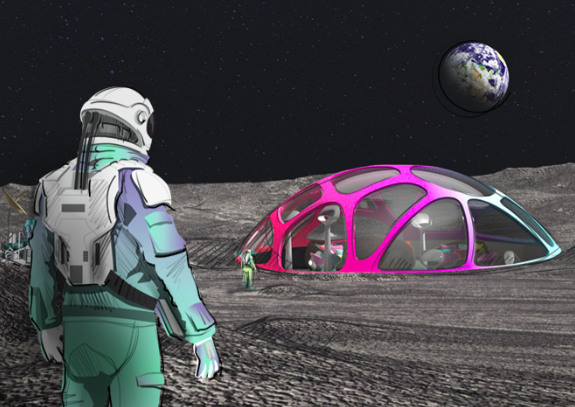
Green.org sat down with Phnam Bagley, Partner at Nonfiction, to learn about the future of sustainable space travel.
Phnam, thanks for being here. Tell us a little bit about you and your background:
I am the co-founder of San Francisco-based industrial and product design firm Nonfiction, where we design the future of everything, on and off planet Earth. My background is in industrial design and space architecture. My team and I design the physical world to support industries like healthcare, wearables, transportation, robotics and aerospace.

My specialty is turning groundbreaking technologies into attainable, intuitive and beautiful products and experiences that help humans become the best versions of themselves. We work with a variety of companies, from startups to Fortune 500 and government agencies across four continents. Some of our clients include NASA, Intel, Facebook, Atari, Philips, Alpine, and Halo Neuroscience.
What would you do with $1 Billion dollars?
Even though it sounds like a lot, a billion dollars is not enough to solve a world-scale problem. It is enough to research and redefine how we think about the problem and start anew. For example, a big problem we have to deal with is pollution and how it impacts societies and the environment. I would spend a billion dollars creating a new international standard of manufacturing that is regenerative, meaning that when we’re done using these products, they can come back to nature without harming ecosystems. We could start with the biggest landfill polluters, like fashion or packaging. Since each and everyone of us is a consumer of either fashion or packaging, we will see the difference it makes and will foster confidence believe that we can apply this same kind of thinking to the other big polluters, like printed circuit boards and batteries.
Why do you think sustainability is such an important topic today?
As the global population is expected to reach nearly 10 billion by 2050, more and more human conflicts sprout from mismanaged resources and displacement. The problem is becoming urgent. At this point, no standards and policies are put in place to build the sustainable future everyone wants. Even if everyone on this planet magically recycled their trash and every country followed the Paris Accord guidelines for emissions, they would not solve the big pollution problem we have. On the other hand, there are pockets of people, companies and organizations who are solving local problems effectively. We need these ideas to be known and scaled appropriately.
We have the advantage of living in a world where young people care about how we treat our planet. Instead of letting them down with greenwashing and inadequate solutions, we should listen to them and give them the resources to enact change. I find it more common for young professionals to choose jobs based on mission alignment rather than going after the biggest brand name or paycheck. Let’s engage them to be creative and boost the green economy before they become cynical.
Globalization, thanks to lower-cost travel, internet access, social media and storytelling, makes it easier for people to relate to problems that are happening to people and ecosystems who live on the other side of the planet.
The space industry is having a hey-day right now, and why is it important to the global green initiative is because space is an industry that has no choice but to be responsible with its resources. It still costs a lot of money to send weight and large volumes to space, we can’t send an infinite amount of water, food, energy to sustain missions. The extreme environment of space has been a constant catalyst for innovation and most space applications are modified to serve an Earth-based purpose.
Just like climate change didn’t happen overnight, solving it won’t happen quickly either. So IiInstead of thinking about ourselves and our short voting cycles, we need to think about many generations in the future and how our decisions today will impact them.
What do you envision your industry looking like 10 years from now?
Hopefully, in the next 10 years we’ll see an increased focus on sustainability with an emphasis on products and systems that support a growing human population and the natural environment simultaneously. To achieve this, we can expect to see greater integration of smart, reliable technologies, the use of renewable materials and most importantly, the definition of regenerative manufacturing systems
What’s most interesting about how industrial design will evolve in the next 10 or 20 years is the changes it reflects in society at large.This is especially relevant when it comes to space travel. As space travel will become more convenient, comfortable and common, the technologies that astronauts use to eat, sleep, work and function will too. To flourish off Earth, humans must rely on an array of new technologies, many of which are just beginning to emerge. Neurotech — the sensing or stimulation of the nervous system for physical, mental and emotional wellness — is promising. Sleep wearables tackle the neurological roots of sleep problems by showing the brain how to fall asleep and stay asleep throughout the night. This technology could support astronauts as they experience 16 sunrises and sunsets daily in orbit, as well as modern humans in an increasingly busy world.
When it comes to health and wellness tech, industrial designers will continue to dial in on centering the human experience across all types of products and related ecosystem services. As more and more medical professionals launch or join startups to innovate new products, the gap between consumer and medical products will continue to close. This will bring significant advancements in integrative medicine, preventative care and alternative versions of health and wellness solutions that offer increasingly comprehensive and individualized support.
What can the average person do to make a difference?
Everyone plays a part in what the future of our world looks like. It is up to individuals, governments and businesses to create a sustainable future in which we can live in better balance with the environment. From an individual perspective, we need to consider how we can reduce our carbon footprints by using energy-efficient technologies and supporting the renewal of our natural resources. Sustainable products and technologies that help us to live more mindfully and in tune with the natural environment and our communities goes a long way too. And all of this starts with curiosity, education, transparency and dialogue. When Earth citizens demand quantifiable solutions instead of rampant greenwashing, things move in the right direction. I would love to see a world where each individual, from the time they are born, has a social and environmental impact score attached to them. Much like the butterfly effect, life decisions have an impact on the present and the future. People should be informed instead of being left to blindly decide the fate of people they will never know.
Phnam, thank you for joining Green.org and sharing your vision for the future of sustainable space travel.
Tune into The Green Podcast, for Phnam’s upcoming episode.